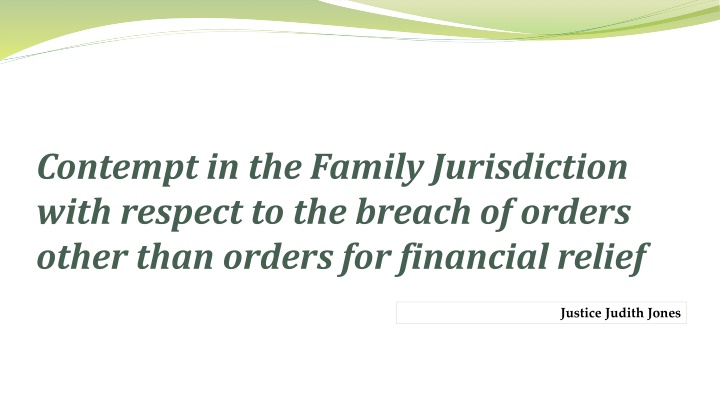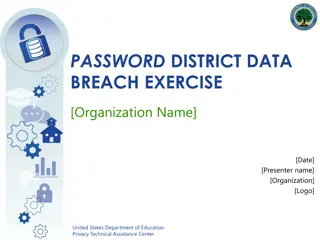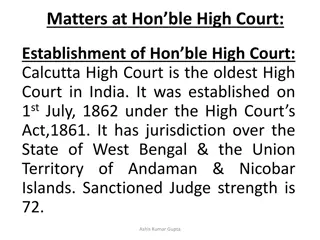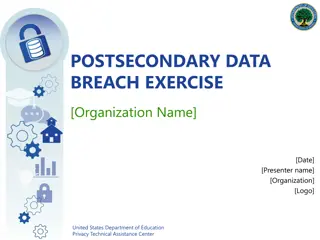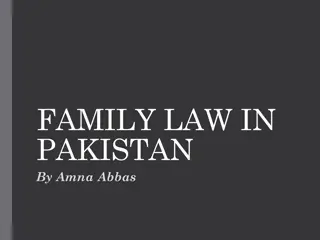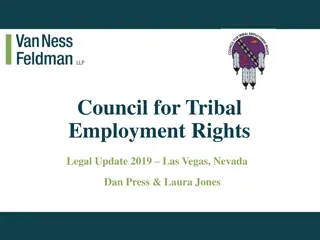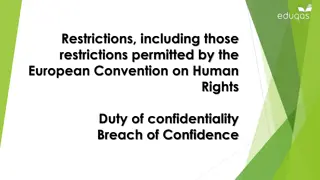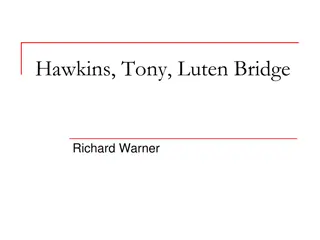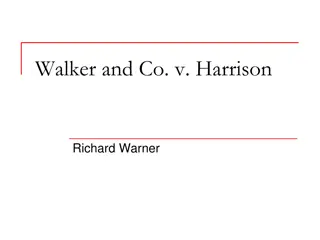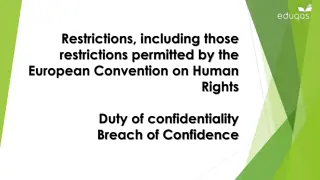Contempt in the Family Jurisdiction with Respect to Breach of Orders
The concept of contempt in the family jurisdiction regarding the breach of court orders other than those for financial relief is crucial for upholding the due administration of justice. Courts have the authority to punish for contempt to safeguard their processes and ensure compliance with their orders. Disobeying court orders undermines the rule of law and can lead to societal breakdown. The law of contempt is universal, preventing interference with the administration of justice. Upholding court orders is vital to maintaining order and respect for the legal system.
Download Presentation

Please find below an Image/Link to download the presentation.
The content on the website is provided AS IS for your information and personal use only. It may not be sold, licensed, or shared on other websites without obtaining consent from the author.If you encounter any issues during the download, it is possible that the publisher has removed the file from their server.
You are allowed to download the files provided on this website for personal or commercial use, subject to the condition that they are used lawfully. All files are the property of their respective owners.
The content on the website is provided AS IS for your information and personal use only. It may not be sold, licensed, or shared on other websites without obtaining consent from the author.
E N D
Presentation Transcript
Contempt in the Family Jurisdiction with respect to the breach of orders other than orders for financial relief Justice Judith Jones
To allow court orders to be disobeyed would be to tread the road towards anarchy. If orders of the court can be treated with disrespect, the whole administration of justice is brought into scorn .If the remedies that the courts grant to correct- ..wrongs can be ignored, then there will be nothing left for each person but to take the law into his own hands. Loss of respect for the courts will quickly result in the destruction of our society. : per O Leary J. in Canadian Metal Co. Ltd v Canadian Broadcasting Corpn (no2) (1975)48 DLR(4th) 641 @ 398 .
Courts of Record all have the jurisdiction to protect its processes by way of punishing for contempt. The more superior the court the wider its jurisdiction in contempt. An inferior court of record, as for example the Magistrates court, at common law only has the jurisdiction to deal with contempt committed in the face of the Court any other jurisdiction must be conferred by statute . The Supreme Court on the other hand has the jurisdiction to deal with both civil and criminal contempt.
The law of contempt is based on the broadest of principles namely that the courts cannot and will not permit interference with the due administration of justice. Its application is universal. : per Sir John Donaldson MR in the A-G v Newspapers Publishing PLC [1987]3 All ER 276 at page 299 .
Today it is no longer appropriate to regard an order for committal as being no more than a form of execution available to another party against an alleged contemnor. The court itself has a very substantial interest in seeing its orders are upheld. per Lord Woolf MR in Nicholas v Nicholas [1997] 1 WLR 314 @326B-C
Rule 3 of the Matrimonial Causes Rules states: Subject to the provisions of these and of any written law, the Rules of the Supreme Court, shall apply with the necessary modifications to the commencement of matrimonial proceedings in and to the practice and procedure in matrimonial proceedings pending in Court .
In Connelly v DPP [1964] AC 1254, at 1347 Lord Devlin said: .The judges of the High Court have in their inherent jurisdiction, both in civil and criminal matters, power (subject of course to any statutory rules) to make and enforce rules of practice in order to ensure that the Court s process is used fairly and conveniently by both sides. (Emphasis mine) As Sir Jack Jacob said (supra at p. 50): The powers of the court under its inherent jurisdiction are complementary to its powers under the Rules of Court; one set of powers supplements and reinforces the other.
The inherent jurisdiction of the court is the reserve of powers a court would exercise to remedy breaches of natural justice, to set aside default orders or judgments in the absence of a party and generally to prevent an abuse of process. In my judgment the inherent jurisdiction of the court cannot be invoked to contradict the rules and to promote a breach of the rules. per Nelson JA in Neil Bennet v Peter McKenzie CvA No 41 of 1999
The applicant must therefore show by way of sworn evidence that: (i) the order sought to be enforced is a valid order that is clear and unambiguous in its terms; (ii)the order has been served or brought to the respondent s attention in circumstances in which the respondent is aware of the coerciveness of the order. (This may easily be achieved by the inclusion of a penal clause on the order served); (iii)there is proof of the breach beyond a reasonable doubt and of the circumstances of the breach. (The fact that the respondent deliberately or knowingly breached the order will have some relevance to means used to punish or coerce the enforcement of the order);
In addition the applicant must show to the satisfaction of the Court that: (i)the application for committal has been properly served and the allegations of the breach are clearly stated on the face of it ; and (ii)sufficient time is given between the service of the application and the hearing to give the respondent a reasonable period of time to attend and the opportunity to be heard.
The guidance which can be provided for future cases is as follows. (1) As committal orders involve the liberty of the subject it is particularly important that the relevant rules are duly complied with. It remains the responsibility of the judge when signing the committal order to ensure that it is properly drawn and that it adequately particularizes the breaches which have been proved and for which the sentence has been imposed. (2) As long as the contemnor had a fair trial and the order has been made on valid grounds the existence of a defect either in the application to commit or in the committal order served will not result in the order being set aside except in so far as the interests of justice require this to be done.
(3) Interests of justice will not require an order to be set aside where there is no prejudice caused as a result of errors in the application to commit or in the order to commit. When necessary the order can be amended. (4) When considering whether to as set aside the order, the court should have regard to the interests of any other party and the need to uphold the reputation of the justice system. (5) If there has been a procedural irregularity or some other defect in the conduct of the proceedings which has occasioned injustice, the court will consider exercising its power to order a new trial unless there are circumstances which indicate that it would not be just to do so. Per Lord Woolfe MR in Nicholls v Nicholls [1997] 2 All ER 97 at page 108 .
Breach of such an order is, perhaps unfortunately, called contempt of court, the conventional remedy for which is a summons for committal. But the real purpose of bringing the matter back to the court, in most cases, is not so much to punish the disobedience, as to secure compliance with the order in the future. It will often be wiser to bring the matter before the court again for further directions before applying for a committal order. Committal orders are remedies of last resort; in family cases they should be the very last resort. They are likely to damage complainant spouses almost as much as offending spouses, for example by alienating the children.
Such orders should be made very reluctantly and only when every other effort to bring the situation under control has failed or is almost certain to fail. In most cases, stern warnings, combined with investigation and an attempt to alleviate the offending spouse's underlying grievances, or an adjournment to allow tempers to cool, will resolve the problem. In some cases, the assistance of the court welfare officer may help to remove some of the tension . :per Omrod LJ in Ansah v Ansah 1977 2 All ER 638 at page 643
Wherever there is a reasonable alternative available instead or committal to prison the alternative must be taken. : per Lord Denning MR in Danchevsky v Danchevesky[1975] Fam 17 @ page 22.
Canadian Metal Co. Ltd v Canadian Broadcasting Corp (no2) (1975)48 DLR(4th) 641 at 398 A-G v Newspapers Publishing PLC [1987]3 All ER 276 at page 299 Nicholas v Nicholas [1997] 1 WLR 314 at 326B-C Jimdar Caterers Ltd. v the Inland Revenue Connelly v DPP [1964] AC 1254, at 1347 Lord Devlin Ansah v Ansah 1977 2 All ER 638 at page 643
Danchevsky v Danchevesky[1975] Fam 17 at page 22 Kanhai v Kanhai FH 02164 of 2010 Amra Srdanovic Farrel v Peter Farrel No FH 0049 of 2006 Marcus Irlacher v Aretha Clarke FH 01950 -2014
